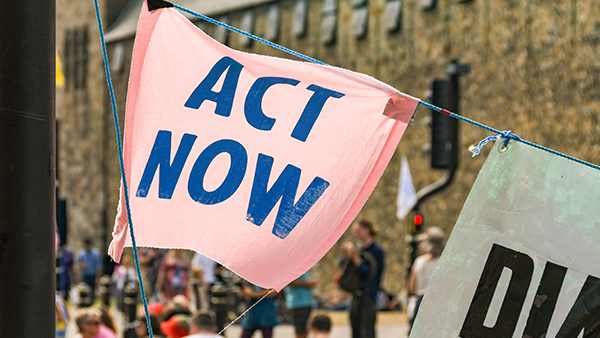An incident at an underground station offers a route to social change…
A few years ago I found myself waiting to get into Vauxhall underground station. A problem with the Victoria Line meant a long queue had formed on the entrance side of a tunnel, which was divided from the exit by a waste high railing. The queue, moving very slowly forward, was resigned and orderly. Then, a single person, whose action inspired a few more people to copy his lead, realised that by ducking under the railing it was possible to move quickly towards the front of the queue.
I don’t know whether the first defector from the queue was motivated by a genuine emergency, self-importance or simple impatience, but his behaviour and that of his emulators had an effect on the queue. There was a discernible shudder of disapproval and by implication a sense that we who continued to line up were morally superior to the queue jumpers. Many of us felt the ambivalence that wells up in car drivers who have been in a traffic jam waiting to leave a motorway. As they sit impatiently another driver, who has ignored all the flashing instructions to join the inside lane, glides up and slips in saving themselves several minutes. The internal voice shouting ‘selfish bastard’ vies with the one shouting ‘why didn’t I think of that?’
What has this to do with understanding and pursuing change? As I have written often before, most attempts at deliberate social change fail and some fail very badly. Government policy has no impact or its planned effects are swamped by unintended consequences. Advocacy campaigns - which are often tendentious - may occasionally succeed in their stated goals but they tend to reinforce a view that change is something we need other people to do for us rather than something we must do ourselves. Social innovation might, with a following wind, succeed in one place but rarely either shifts things long term or provides a model that can be replicated. Furthermore, the characteristics of the world that make lasting change hard to achieve – complexity, pace, volatility – are intensifying.
The most effective approach to change in the modern world uses ways of thinking and acting which seem so different as to be almost contradictory. One the one hand, we need to look at whole systems, aiming to shift the equilibrium which holds those systems together. On the other hand, we need to be more entrepreneurial, embarking on change strategies with a varied tool kit ready to experiment, learn, adapt, cope with failure and seize opportunities.
The latter approach is fast, focussed, adaptive and ambitious. Its motto might be ‘it’s not hope that leads to action but action that leads to hope’ or ‘don’t just sit there, do something. The former approach is slow, broad, wide, patient, methodical, accepting of complexity. Its motto is Lincoln’s advice ‘if I had six hours to chop down a tree I’d spend the first four sharpening the axe’ or maybe ‘don’t just do something, sit there’.
Combining the approaches isn’t easy. It means recasting Gramsci’s brilliant but rather downbeat injunction to revolutionaries to combine ‘pessimism of the intellect and optimism of the will’ into the more hopeful combo for change-makers of ‘humility of the intellect and ambition of the will.
One way of reconciling the two systems is to create teams with different skills and mindsets and to foster mutual respect among the members. Another is to becoming properly immersed in the problem you are trying to solve so you understand the barriers better and deepen your passion for change. But it’s also valuable if everyone involved in a project shares a conceptual framework and common language.
Which takes me back to Vauxhall station. What happened that morning was a drama involving the actors in what I now call coordination theory. The theory argues that there are four basic ways to approach the challenge of getting people to do things together: the hierarchical (stuff like leadership, strategy, expertise, rules), the solidaristic (stuff like belonging, equity, shared values), the individualistic (stuff like self-interest, competition, enterprise) and the fatalistic (coordination is intractable and even if it happens it doesn’t solve the things that make it hardest to be human).
This is a theory about systems. It proposes analysing social phenomena through the prism of how the modes of coordination (particularly the first three, active, ones) are expressed. It also proposes that the most effective policies, systems, organisations and even places manage to mobilise the three active modes; because, as well as being a modes of coordination, each is a vital source of insight and power. I’ve offered evidence to back up this contention in earlier posts.
But the theory is also dynamic and contingent. It argues that such fully engaged combinations are rare and difficult to create. This is partly because equilibria are subject to changes in the external environment, but more because each mode contains the impulse to be dominant. In this struggle for dominance if one mode becomes stronger or weaker it sets off an unpredictable reaction in the other modes.
That’s what happened at Vauxhall station. The queue I joined was hierarchical and fatalistic – following the rules resignedly. The queue jumpers were shameless exponents of individualism. The reaction to them was for the queue to become more solidaristic – we defined ourselves not just as compliant to authority but as members of a tribe of people motivated by the values of justice and social responsibility.
In practicing humility of the intellect and ambition of the will we can use coordination theory to understand and re-imagine systems and to prepare us for the unpredictability of change.
Related articles
-
The public are ready to go further and faster on net zero
Anthony Painter
The public are ahead of policy-makers and, indeed, most of the business world. COP26 is an enormous opportunity to catch up. Global leaders should take it.
-
Can progressives ever stop the in-fighting?
Matthew Taylor
Biden's victory has caused the left and moderates to fracture again.
-
Can President Biden bring America together again?
Anthony Painter
There is a long road ahead for the new president.




Join the discussion
Comments
Please login to post a comment or reply
Don't have an account? Click here to register.
Queuing - an curious trigger for an original thought; Coordination Theory... simple, and makes a lot of sense. Resonates with me, too. Yes, it seem to explain well the described mechanism. Interesting observation, thank you!